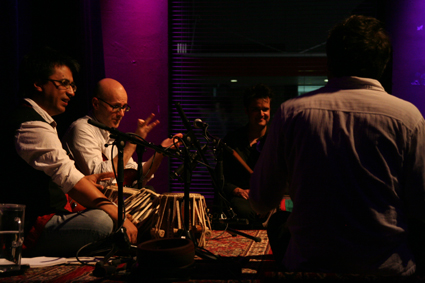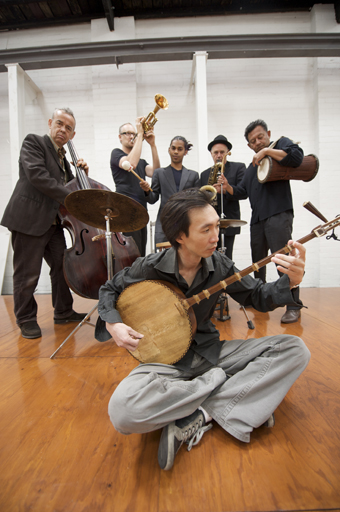creative doctorates & the health of music education
matthew lorenzon: performance-led research in music

Dheeraj Shrestha, Toby Wren, Shenton Gregory and Tunji Beier
photo Lauren Lucille
Dheeraj Shrestha, Toby Wren, Shenton Gregory and Tunji Beier
BY TRANSLATING THEIR MUSICAL PRACTICE INTO LANGUAGE, MUSICIANS ARE COMING UP AGAINST A PHILOSOPHICAL PROBLEM THAT HOLDS CENTRESTAGE IN THE DISMANTLING OF AUSTRALIA’S UNIVERSITY MUSIC DEPARTMENTS.
While vice-chancellors attack music for its calculable expense, supporters defend it for its alleged evasion of expression in language and number. Practice-led research in improvisation, composition, classical performance and sound design is proving both views misguided, opening the way for an articulate musical culture able to argue its worth and attract research funds.
In Australia, the uptake of practice-led research in music has been piecemeal and unregulated. Philip Samartzis of Royal Melbourne Institute of Technology (RMIT) was one of the first wave of performance-led researchers, studying with Philip Brophy in 1997. The process was one of trial by error, as Samartzis tells it, “none of us had experience in practice-led research.” He confesses that coming from experimental music made the process easier. “The experimental tradition already tries to articulate things differently, tests things out in performance, is reflexive, peer-reviewed […] But as a student I knew how much independence, supervision, stubbornness you needed to get over the line.”
Today, Graduate Convenor at the Victorian College of the Arts (VCA) Robert Vincs gets five or six inquiries about practice-led research a week. Taking a strong interest in theory and philosophy, VCA postgraduate students explicitly interrogate the line between music and language. To Vincs, an overly structural approach to the relationship between music and language is limiting our ability to conceptualise creativity. “I can think of nothing more important to humankind than creativity,” Vincs asserts. His own work on computer-simulated improvisation has helped him to understand creativity as a process of play. While it could be assumed that Vincs’ definition of creativity would deem the scientific research framework irrelevant for asking musical questions, the reality is not so dire. “The highest resistance I get is from the students themselves. They think they have science models like monkeys on their backs, but it’s not the case.” Students, Vincs says, need only describe what they are doing and why and how they are doing it. “People get stuck on the first point. People find it hard to realise what they are doing.”
Part of the third generation of Australian practice-led researchers and a former student of Samartzis, Western Australian Academy of Performing Arts (WAAPA) Post-Doctoral Fellow Cat Hope is under no illusion as to how the language of practice-led research shapes creative inquiry. To Hope, the problem is not so much framing musical processes as research, but squeezing them into the hyped-up language of grant applications. Fortunately, creative artists are uniquely placed to succeed at such writing. “Musicians are well equipped for practice-led research because a lot of us have written grant applications before we enter academia. You have had to say how innovative you are more times than you care to remember.” In arguing for innovation, interdisciplinary and technological projects are particularly easy to promote. Many projects at WAAPA are moving in this direction. A particularly successful example is Music Performing Arts doctorate student Stuart James, who is developing a system to control timbral spatialisation gesturally using touch interfaces. But Hope is careful to note that the innovation of a work does not necessarily reflect its value. “It is easier to articulate innovation than value,” Hope reflects after a gruelling research evaluation exercise, wondering whether assessment criteria adequately evaluate the creative outcomes they encourage.
Vanessa Tomlinson of the Queensland Conservatorium at Griffith University believes that articulating one’s practice improves the outcomes, so long as you distinguish between practice, practice-led research and pure research. “Not all creative work is research. It becomes research when you put forward a hypothesis and proceed with an experiment. […] When you investigate with some clarity or consciousness the process becomes fascinating in all areas, music included.”
It is interesting that in the field of improvisation the problem of combining language and music seems difficult but also leads to some of the most interesting and controversial outcomes. As a jazz musician, Queensland Conservatorium PhD candidate Toby Wren already had an interest in rhythmically complex music, but the Carnatic music of South India came as a revelation: “There I found a perfect expression of many rhythmic things I was experimenting with in jazz,” Wren recounts with obvious wonder. Unhappy writing this transformative encounter down as a garden-variety ineffable experience, Wren travelled to South India to study Carnatic tala. His studies led to another difficult-to-describe phenomenon: he noticed a stylistic bleed from Carnatic music into his jazz improvisations. “I wanted to know how it was happening and why it wasn’t happening more. They are similar styles, but have different ways of thinking.” The unexpected fusion of styles in his own playing led Wren to a contemplation of harmonic tension and release in jazz and rhythmic tension and release in Carnatic music. Wren’s own cross-cultural practice is the basis for his current PhD research exploring the shortcuts and working methods of improvisers.
But the process of Wren’s research has not always led to answers of greater linguistic definition, as might be expected from the above summary. More and more often, Wren finds himself asking linguistic questions that require musical answers, much to the chagrin of his supervisors. “I started with worded questions that had worded answers, but I am moving towards worded questions where the answers are entirely musical. What will it sound like when I combine this and this? What kind of music will I make if I get together with this person?” Wren hopes his supervisors will let him make the final chapter of his thesis a recording.

Way Out West, from left to right back Howard Cairns, Peter Knight, Rajiv Jayaweera, Ray Pereira, foreground Anh Nguyen
photo Steve Gale
Way Out West, from left to right back Howard Cairns, Peter Knight, Rajiv Jayaweera, Ray Pereira, foreground Anh Nguyen
Queensland Conservatorium PhD alumnus Peter Knight shares Wren’s suspicion of the presentation of research results in scientific writing. In particular, he questioned the recording of the creative part of his research. If examiners were going to insist on a recording of his improvisations, Knight decided, the focus of his PhD would have to be the medium conveying his improvised message. “I decided that my process was going to use improvisation, but that I was going to focus on the process of recording that improvisation. I was editing the improvisations as well as I could and documenting the editing process. I discussed that process. I would take only three-four minutes of the improvisation because what works in a recorded setting is different from in a concert.”
Knight’s thesis also provided a partly autoethnographic listening guide to the recordings. “I was trying to create something usable, whether people wanted a richer listening experience or they were composers themselves.” Students and teachers around Australia have since consulted the thesis enthusiastically. The problem of talking about music did not go away, however, and again the conclusion of the exegesis proved the greatest challenge to the examiners. Knight’s style was literary and fragmentary, reflecting his musical processes. “I wanted to leave it a bit open-ended,” Knight reflects on his conclusion. “Maybe being unsure is where the vitality of the work resides.”
The uncertainty of Wren and Knight’s wider academic community in regards to the combination of creative and exegetical elements of their projects is indicative of the lack of standardisation of practice-led research in Australia. Polifonia, Europe’s largest music in higher education project, has been evaluating practice-led research since 2004, while the UK’s Arts and Humanities Research Council released its report on “Practice-Led Research in Art, Design, and Architecture” in 2007. Today, practice-led research forms the cornerstone of several schools of music in mainland Europe, notably Belgium’s Orpheus Institute. Australian institutions have each individually squeezed their programs into the rather hazy shapes of the Australian Qualifications Framework. While this has allowed each institution to capitalise on its strengths, it has possibly undermined the institutionally recognised value of creative outcomes. Future Fellow at the ANU School of Music (one of the slower institutions to take up the practice-led research challenge, much to its obvious disadvantage) Aaron Corn attests that a strong combination of performed and paper output is necessary in an academic CV and that there is not yet true parity of institutional regard for these two kinds of research outcome.
Tertiary music departments across the Western world, though not in some of the world’s poorest countries, are either adapting to government funding models that favour research over creative activities, or their intra-university support is being brutally slashed. There is no ambiguity as to where the impetus for change is coming from. With one-on-one classes being the norm, staff attracting little research funding, but cohorts providing a vital link to the wider community, conservatoriums have generally been accepted as expensive but valuable parts of universities since they were merged with academic schools of music during the Dawkins reforms. The current “crisis” of conservatorium funding is artificial.
We have known this since 1999 when the La Trobe School of Music was closed in the full blush of fiscal health. Many of the current generation of university executives mistakenly (and with humiliating consequences) see in conservatoriums a needless burden, rather than recognising them as the effective public outreach machines they really are. Practice-led postgraduate research degrees attempt to bridge the institutionalised research/creative divide and patch this invented funding gap. We are already seeing a new generation of articulate performers able to offer up dazzling research questions and advocate the place of music in society, but we may also see a drop in the standards of creative outcomes—music’s most powerful advocate—as musicians struggle to fit their practice into jewel cases, 16-bit files and the printed word.
RealTime issue #110 Aug-Sept 2012 pg. 8






